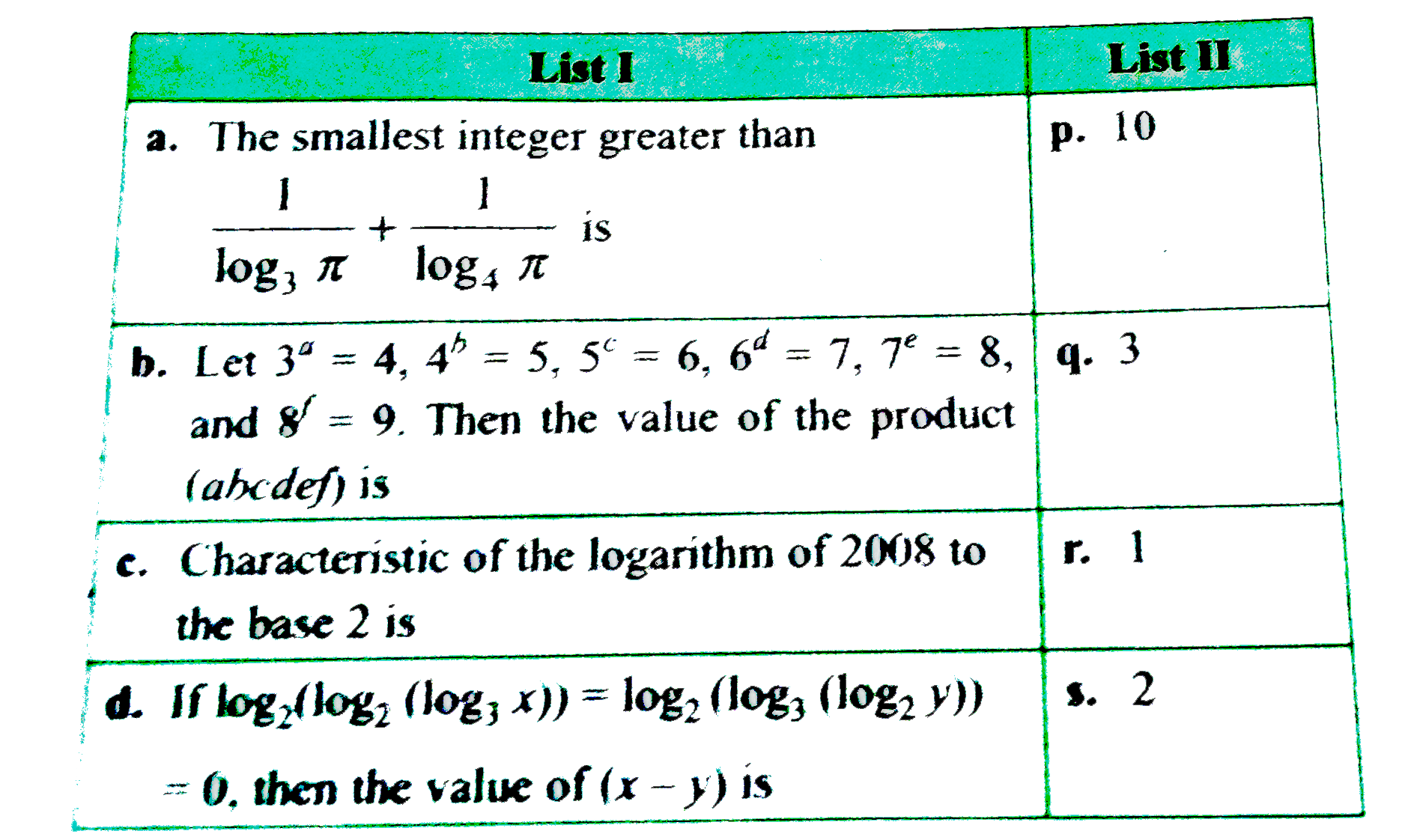If p,q∈N satisfy the equation xx=(√x)2, then pandq are relatively prime (b) twin prime (c) coprime if (log)qp is defined, then (log)pq is not and vice versaSolution in Tamil
p+q=5
|p−q|=4
pq=4
if logqp is defined, then logpq is not and vice versa
The correct Answer is:A, C, D
x√x=(√x)x,p,q∈N
⇒√xlogx=xlog√x
orlogx[√x−x2]=0
⇒logx=0or[√x−x2]=0
⇒x=1or4
Topper's Solved these Questions
- LOGARITHM AND ITS PROPERTIESBOOK - CENGAGECHAPTER - LOGARITHM AND ITS PROPERTIESEXERCISE - Exercise (Comprehension)
6 Videos
- LOGARITHM AND ITS PROPERTIESBOOK - CENGAGECHAPTER - LOGARITHM AND ITS PROPERTIESEXERCISE - Exercise (Matrix)
3 Videos
- LOGARITHM AND ITS PROPERTIESBOOK - CENGAGECHAPTER - LOGARITHM AND ITS PROPERTIESEXERCISE - Exercise (Single)
50 Videos
- LOGARITHM AND ITS APPLICATIONS BOOK - CENGAGECHAPTER - LOGARITHM AND ITS APPLICATIONS EXERCISE - Subjective Type
9 Videos
- MATHMETICAL REASONINGBOOK - CENGAGECHAPTER - MATHMETICAL REASONINGEXERCISE - JEE Previous Year
10 Videos
Similar Questions
Find the value of x satisfying the equations log3(log2x)+log1/3(log1/2y)=1 and xy2=9
View Solution
View Solutionlog418 is
View SolutionFind the value of x satisfying the equations log3(log2x)+log1/3(log1/2y)=1 and xy2=9
View SolutionStatement-1: ~(p↔~q) is equivalent to (p↔q).
Statement-2: ~(p↔~q) is a tautology.
View SolutionIf p,q∈N satisfy the equation x√x=(√x)x, then pandq are (a)relatively prime (b) twin prime (c) coprime (d)if (log)qp is defined, then (log)pq is not and vice versa
View SolutionIf α,β are the roots of x2−px+q=0andα′,β' are the roots of x2−p′x+q′=0, then the value of (α−α′)2+(β−α′)2+(α−β′)2+(β−β′)2 is 2{p2−2q+p'2−2q′−pp'} 2{p2−2q+p'2−2q′−qq'} 2{p2−2q−p'2−2q′−pp'} 2{p2−2q−p'2−2q′−qq'}
View SolutionIf the equations x2+px+q=0andx2+p′x+q′=0 have a common root, then it must be equal to a.p′−p′qq−q′ b. q−q'p′−p c. p′−pq−q′ d. pq′−p′qp−p′
View SolutionIf p,q varepsilon N satisfy the equation x^(sqrt(x)=(sqrt(x))^(x)) then p&q are
View SolutionIf p and q are co-prime numbers, then p2 and q2 are (a) coprime (b) not coprime (c) even (d) odd
View SolutionIf logxq−r=logyr−p=logzp−q prove that xq+r.yr+p.zp+q=xp.yq.zr
View SolutionIf lim_(x rarr0)(x+ln(sqrt(x^(2)+1)-x))/(x^(3))=(p)/(q) where p and q are coprimes then find the value of |p^(2)-q^(2)|
View SolutionIf p,q∈N satisfy the equation x√x=(√x)x, then pandq are (a)relatively prime (b) twin prime (c) coprime (d)if (log)qp is defined, then (log)pq is not and vice versa
View SolutionIf the equations x2+px+q=0andx2+p′x+q′=0 have a common root, then it must be equal to a.p′−p′qq−q′ b. q−q'p′−p c. p′−pq−q′ d. pq′−p′qp−p′
View SolutionThe line Ax+By+C=0 cuts the circle x2+y2+ax+by+c=0 at PandQ . The line A′x+B′x+C′=0 cuts the circle x2+y2+a′x+b′y+c′=0 at RandS. If P,Q,R, and S are concyclic, then show that |a−a'b−b'c−c'ABCA'B'C'|=0
View SolutionIf p>1andq>1 are such that log(p+q)=logp+logq, then the value of log(p−1)+log(q−1) is equal to 0 (b) 1 (c) 2 (d) none of these
View Solution
